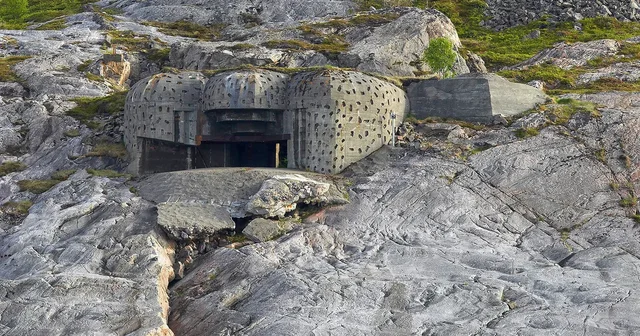
Norway revives Cold War bunkers in face of Russian threat


Norway's proximity to the Soviet Union during the Cold War led the Nordic country to build many military bunkers - some of them large secret bases for aircraft and warships. Today, in the face of renewed tensions with Russia, these underground structures are coming back into the spotlight.
Every year, hundreds of thousands of tourists visit northern Norway, but what they never see is the secret world hidden deep within the mountains: fighter jets and nuclear submarines sheltered in giant underground caves.
Norway is a country of bunkers. At the height of the Cold War, this sparsely populated, mountainous country had around 3,000 underground structures where the Norwegian armed forces and their allies could hide and resist any invaders. Many of these bunkers date back to when Norway was part of Hitler’s Atlantic Wall during World War II – or even earlier – and the Norwegian public had little or no knowledge of their existence.
Today, as war engulfs eastern Ukraine, Norway is reactivating two of the Cold War's most iconic underground structures.
Near the Russian border, north of the Arctic Circle, the hangars of Bardufoss Air Base and Olavsvern Naval Base look like scenes from a spy movie, with their polished rock walls, gleaming concrete and military hardware. Olavsvern Base, carved into a mountain and protected by some 275 meters of gabbro rock, features a 909-meter-long exit tunnel with a massive blast door.
Why are these giant bunkers needed today? The Soviet Union – the original reason for their construction – no longer exists. Does it still make sense to pour millions into maintaining such expensive structures?
In promotional photos for the reopening of Bardufoss, a US F-35 Lightning II fighter jet looks like a predator under the spotlights, under the arched roof of the hangar. The base, opened in 1938, was used by the Germans during the war to protect the battleship Tirpitz. After the war, the Norwegian air force turned it into a safe haven for fighter jets from any Soviet attacks.
After closing nearly 40 years ago, Bardufoss is being revived. The reason? To protect F-35s, which cost $80–110 million each, from attacks by suicide drones that cost just $300. The solution? Disperse the planes in different locations or, even better, in fortified bunkers deep in the mountains.
A look at the map explains why the Olavsvern naval base was built.
Ndodhur pranë nyjës strategjike ku Deti Norvegjez takohet me Detin Barenc, Olavsvern ndodhet në një pikë kyçe të quajtur “Hendeku i Arinjtë”, një rrugë kalimi për nëndetëset dhe anijet ruse që synojnë Atlantikun. Ndërtimi i bazës nisi në vitet 1950 si përgjigje ndaj fuqizimit të Flotës Veriore Sovjetike, dhe kostoja totale arriti rreth 450 milionë dollarë – shumica e së cilës u mbulua nga NATO. Baza përfshin një qendër komande nëntokësore, doke në thellësi, tunel daljeje dhe një kantier riparimesh.
Pas rënies së Bashkimit Sovjetik, baza mbeti aktive dhe u përdor për misione të NATO-s në Oqeanin Arktik. Por në 2009, parlamenti norvegjez votoi për mbylljen e saj, dhe në 2013 ajo u shit për vetëm 7 milionë paund një kompanie private. Aty u strehuan karavanë dhe makina klasike, madje disa anije kërkimore ruse u lejuan të hynin në këtë objekt më parë tepër të ruajtur.
Në 2020, kompania WilNor e lidhur me ushtrinë norvegjeze, bleu shumicën e aksioneve dhe nisi rinovimin dhe modernizimin e saj. Marina amerikane ka shprehur interes për të përdorur bazën për nëndetëset e saj bërthamore.
Pra, arsyeja për reaktivimin është e thjeshtë: Rusia.
Shqetësimet e sigurisë nuk nisën në vitin 2022 me pushtimin e Ukrainës, as në 2014 me aneksimin e Krimesë, por shumë më herët. Sipas studiuesit Andreas Østhagen:
“Në periudhën 2006–2008, kishte shumë investime në Flotën Veriore të Rusisë dhe rifilluan stërvitjet ushtarake në Arktik – për herë të parë që nga fundi i Luftës së Ftohtë.”
“Rusia e Putinit nuk është Bashkimi Sovjetik,” shton ai, “por për sigurinë norvegjeze, problemet janë po ato: si ta pengesosh Rusinë dhe, nëse shpërthen lufta, si ta luftosh Rusinë?”
Por Norvegjia nuk është e vetmja. Rusia ka rihapur rreth 50 baza të Luftës së Ftohtë në Arktik. Suedisë i është rikthyer baza nëntokësore e Muskö, pranë Stokholmit. Kina ka ndërtuar një bazë të re nëntokësore në ishullin Hainan në Detin e Kinës Jugore dhe një qendër gjigante komande pranë Pekinit. Irani ka ndërtuar “qytetin nëntokësor të raketave” në Gjirin Persik.
“Psikologjia e bunkerëve bërthamorë është shumë e fuqishme,” thotë Sir Humphrey, një studiues i pavarur i Luftës së Ftohtë. “Janë rrënjosur thellë në psikikën tonë – veçanërisht imazhi i një gjenerali të çmendur në një qendër komande à la Dr. Strangelove.”
Sipas ekspertit Paul Ozorak, autor i Underground Structures of the Cold War:
“Vendosja e nëndetëseve dhe avionëve në tunele është ende një mënyrë e mirë për t’i mbrojtur nga bombardimet ajrore, edhe nëse përdoren bomba të fuqishme bunker-buster.”
Megjithatë, vendet si Britania mund të hezitojnë të ndjekin shembullin norvegjez për shkak të kostos shumë të lartë. Në Britani, shumë prej këtyre strukturave janë shitur si muze, klube nate apo thjesht janë mbyllur e shkatërruar. Shumë janë përmbytur dhe të papërdorshme.
" Many of them have been stripped of their equipment. Reintegration and restoration of communication systems would be extremely costly," Ozorak says.
There are also security concerns. Bunkers like Olavsvern, left unchecked for years, could have been compromised by foreign intelligence services, even if they have not had official visits from Russian ships.
“ There is limited benefit from a structure that everyone knows exists and has been a target for 60 years,” says Sir Humphrey. “The bunkers were built to withstand a nuclear bomb exploding nearby – not a GPS-guided bomb falling right into the ventilation shaft. ”
However, some facilities in Britain remain active. Such as the RAF bunker in Buckinghamshire, the Northwood Headquarters, and MOD Corsham, which houses a secret communications centre over a vast network of Cold War tunnels.
Meanwhile, the British Cabinet Office has reclassified documents on nuclear war planning that were made public after the Cold War – another sign that fear has not died down.
"At the end of the day, if you're afraid of a surprise attack, the natural instinct is to go underground," Ozorak concludes.
-
Netanyahu: Israel's attacks on Hamas will intensify
March 30, 19:23 -
Iran's president rejects Donald Trump's call for nuclear talks
March 30, 19:07

Rama-Meta, si aleanca e 1 Prillit zhbëhu Shqipërinë
ideas



top
Alfa recipes
TRENDING 
services
- POLICE129
- STREET POLICE126
- AMBULANCE112
- FIREFIGHTER128

























